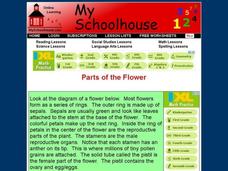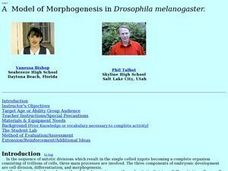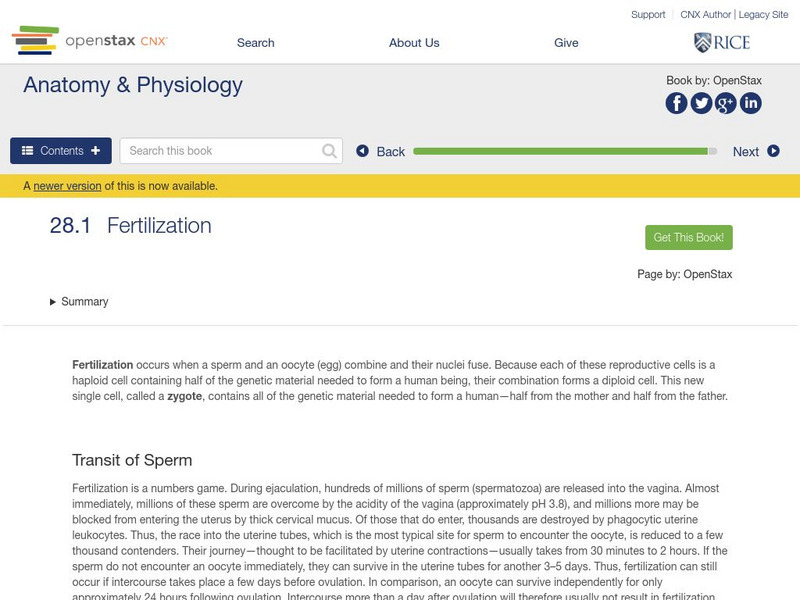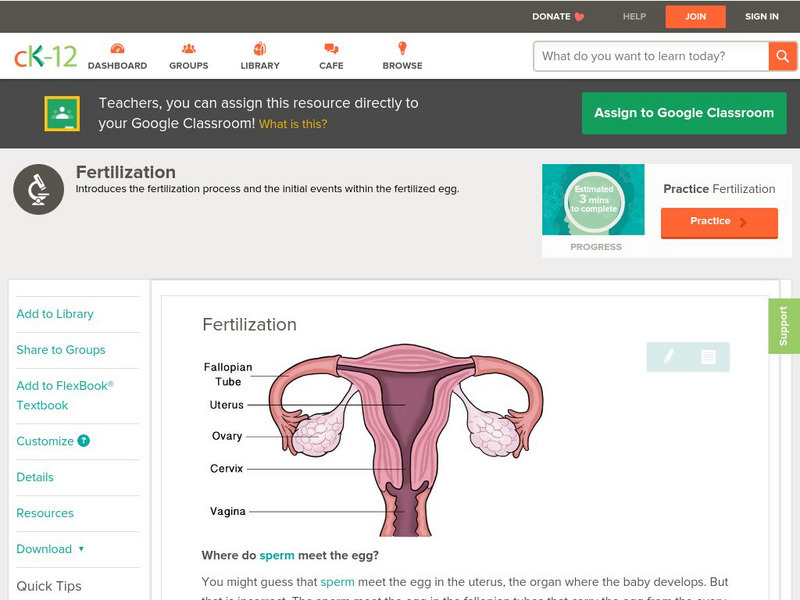Curated OER
Cnidarians
For this cnidarians worksheet, students will read 4 descriptions and identify each as either the polyp or medusa form of cnidarian. Then students will complete 3 short answer questions about the characteristics of cnidarians. Finally,...
Curated OER
Genetics: Knowledge Quiz
In this genetics quiz worksheet, students complete a set of 10 multiple choice questions covering various concepts of genetics. A reference web site is given for additional resources.
Curated OER
Pollination Power
Young scholars go out into the garden and observe pollinating animals through hand lenses. In this pollination lesson plan, students also discuss how animals carry seeds to create new plants elsewhere.
Curated OER
7th Science Quiz
This seventh grade life science quiz has a professional appearance and well-written multiple-choice questions. However, it seems to cover too broad a variety of biology topics for only 15 questions to fully assess. There is one question...
Biology Junction
Seed Plants: Gymnosperms and Angiosperms
One of the reasons plants found success on land relates to seed development. Scholars learn about many different forms of seeds and how they changed over time. It describes the structure and function of many different types of seeds in...
Curated OER
Buzzy, Buzzy Bee
Students simulate honeybees pollinating flowers. In this pollination lesson, students role-play the process of pollination over the course of several seasons. Students graph results and share their graphs with the class.
Curated OER
Flower Structure and Reproduction
In this plant science worksheet, students color and label the different parts of the flower. They write short answers to 14 questions about flowers.
Curated OER
Amphibians
In this amphibian worksheet, students will review the characteristics of the class Amphibia, including frogs and toads, salamanders, and caecilians. This worksheet has 3 short answer questions, 5 matching questions, 6 multiple choice,...
Curated OER
Embryology as Evidence of Evolution
Students observe the two major developmental pathways (protostome and deuterostome). They analyze data regarding differences in nucleotide sequences and construct a phylogenetic tree. They observe the similar evolutionary history shared...
Curated OER
How Do Organisms Reproduce
Students examine the difference between mitosis and meiosis, and describe the steps involved in meiosis and the significance of each step. They create a diploid nucleus containing two pairs of chromosomes using clay.
Curated OER
Bioethics: Debates in Human Genetics
Students, in groups, research and prepare a debate regarding various bioethical situations. After the debates, each student prepares a ortfolio outlining their own personal opinions.
Curated OER
Sponges, Cnidarians, Flatworms, and Roundworms
For this simple animals worksheet, learners review the characteristics of sponges, cnidarians, flatworms, and roundworms. This worksheet has 12 matching questions.
Curated OER
Parts of the Flower
For this biology worksheet, students examine a diagram of a flower and read a selection that describes all of the parts including the petals, the stamen, the anther, and the sepals. They answer 11 on-line fill in the blank questions...
Curated OER
The Life Cycle of a Flowering Plant
In this flowering plant activity, learners will review vocabulary words associated with the life cycle of flowering plants. This activity has 7 matching and 3 short answer questions.
Curated OER
Pollen & Pollination
Young scholars identify the different ways things are pollinated and how to manage pollen. In this pollination lesson students complete an experiment on how moths pollinate flowers.
Curated OER
Dragon Genetics-Independent Assortment and Genetic Linkage
Students build chromosome models using popsicle sticks. In this biology lesson plan, students simulate the Law of Independent Assortment. They use Punnett squares to predict the resulting genotype and phenotype.
Curated OER
Non-Seed Vascular Plants
In this non-seed vascular plant activity, students review the characteristics of sporophytes, lycophytes, sphenophytes, and pterophytes. This activity has 19 fill in the blank, 4 true or false, and 2 short answer questions.
Curated OER
Ferns and Gymnosperms
In this fern and gymnosperm worksheet, students will read about two types of vascular tissue: xylem and phloem. Then students will read about the difference between sporophytes and gametophytes. Using this information students will...
Curated OER
Sponges and Cnidarian Crossword Puzzle
In this marine science worksheet, students complete a crossword puzzle with 32 questions on sponges and cnidarian. They identify the different characteristics of sponges and cnidarian.
Curated OER
Reproductive System
Fifth graders identify and define parts of the reproductive system. In this health activity, the teacher introduces the parts of the reproductive system, then students match body part cards to the corresponding definition cards.
Curated OER
A Model of Morphogenesis in Drosophila Melanogaster
Students investigate the following scientific terms and ideas: rates of diffusion, the role of morphogens in the development of larva, the chemical dynamics of a cell, and the significance of embryo polarity during development.
OpenStax
Open Stax: Anatomy & Physiology: Fertilization
Students learn about the fertilization process of an egg and sperm cell during human reproduction.
CK-12 Foundation
Ck 12: Life Science: Fertilization
[Free Registration/Login may be required to access all resource tools.] The sperm and egg don't look anything like a human baby. After they come together, they will develop into a human being. How does a single cell become a complex...
PBS
Pbs: Nova: Fertility Throughout Life
This presentation compares & contrasts male and female fertility from pre-infancy through late adulthood.























